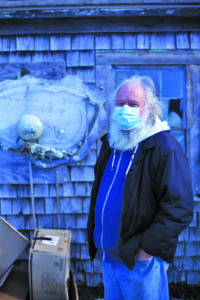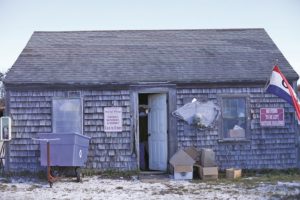Tucked in the magazine rack at the Wellfleet swap shop, a few reproductions of 17th-century Dutch paintings stand out among glossy periodicals. In one, a richly dressed figure commands the center of a Thomas de Keyser painting. He is surrounded by objects of his time and place: tapestries, globes, and finely wrought wooden furniture. Like much Dutch painting of this era, the picture communicates a vivid personality and reflects the culture of its time, highlighting Holland as a center of trade, rich with materials, craft, and art.
It’s somehow right to find a copy of this painting here. For the contents of this ramshackle house at the transfer station reflect a culture, too. The swap shop is full of the personalities and objects of this place.

“It’s a place of repurposing,” John Capello says, cradling a pair of teacups in his burly hands. A blue floral pattern decorates the porcelain cups and saucers.
“The return policy is great,” says Linda of Wellfleet. (She would give only her first name.) A lover of local birds, Linda finds a plastic bird feeder and a glass jug. The elegantly proportioned jug appears as if it could have had a past life fermenting alcohol. She plans to use it to store thistle seed for chickadees.
“This is for my daughter. She teaches kindergarten,” explains Anne Dickerman of Wellfleet and Braintree, gesturing toward a figurine of Uncle Sam, legs splayed, surrounded by fireworks and festooned in Fourth of July regalia. In addition to this prime piece of summer holiday kitsch, she has scored Legos and games for her grandchildren. “Everything I get is for someone else,” she says.

“I’ll take it back to Lansing,” says Joel Panetta, holding up a model sailboat. This detailed replica of a schooner includes multiple sails, a complex rope system, and miniature lifeboats. Panetta will display it in his Michigan home to remind him of Wellfleet, where he comes twice a year to visit a friend. “It would be interesting to know who put it here,” he muses.
Roland Blair, the volunteer coordinator at the swap shop, is one of the few people who knows where his prized acquisition came from. It didn’t actually come from the swap shop itself but rather from a connection forged there.

“I’m a musician,” he explains. While looking at a “cheap old guitar” with swap-shop regular Mike Parlante, he got an offer of something better: Parlante agreed to give him a 1965 Guild guitar he had collected.
“People come here and chat on Saturday mornings,” says Blair, reflecting on how the swap shop has replaced the post office as a center of community life.
Blair has even memorialized some swap shop patrons in an original song. “I mostly played in my bedroom from age 21, when I returned from Vietnam, until age 60,” he says. But recently he recorded a CD of original songs about Wellfleet and beyond, including one tune titled “Swap Shop Sally.”
As he works, Blair greets regulars, the swap shop bustling with life on an off-season Saturday morning. A revolving cast of characters stream in and out, donating items, scouring the shelves for treasures, and chatting between racks piled high with dishes, toys, books, and random surprises ranging from a giant stuffed fish to those prints of Dutch paintings.
None of this would have been possible without the swap shop’s biggest donation yet: the building itself.
“It’s hard to believe I actually lived in this,” says Dan Silverman, a carpenter, and Wellfleet’s retired fire chief and current town moderator, standing in front of the shingled cottage that houses the shop. Beginning in the 1970s, Silverman rented the house for $80 a month before buying it for $18,500. Silverman guesses it was built in the 1940s. It stood on his property until 1987.

That’s when Silverman’s wife, Janice Gray, moved in and the place began to feel too small. The couple soon hatched plans to demolish it and build something new on the land. “I heard Chuck Cole on WOMR asking if anyone had a small shed for a swap shop at the dump,” recalls Silverman. He and Janice offered the house on the condition that it be removed from their lot.
With a volunteer crew, the house was flaked, cut into six pieces, with the four walls laid out flat on a flatbed truck. It spent a year at the transfer station before it was put together again to become a treasured site of community exchange.
Now the building is deteriorating, with the trim rotting in places, shingles missing, and at least a few broken windows. There’s talk of replacing it with a metal building, though Blair says he’s hoping to preserve at least a piece of the original building in a new space.

“There’s lots of sentiment to this house,” Silverman says, but he admits that he’s not emotional about its demise. What he cares about is its purpose. “I just hope the town continues to have a swap shop,” he says.
Blair says there are two kinds of swap shop devotees: “One wants it all organized and the other wants everything piled on top of each other.” That duality, in a place where the value and destiny of objects is weekly renegotiated, is not likely to change no matter what the abode.
